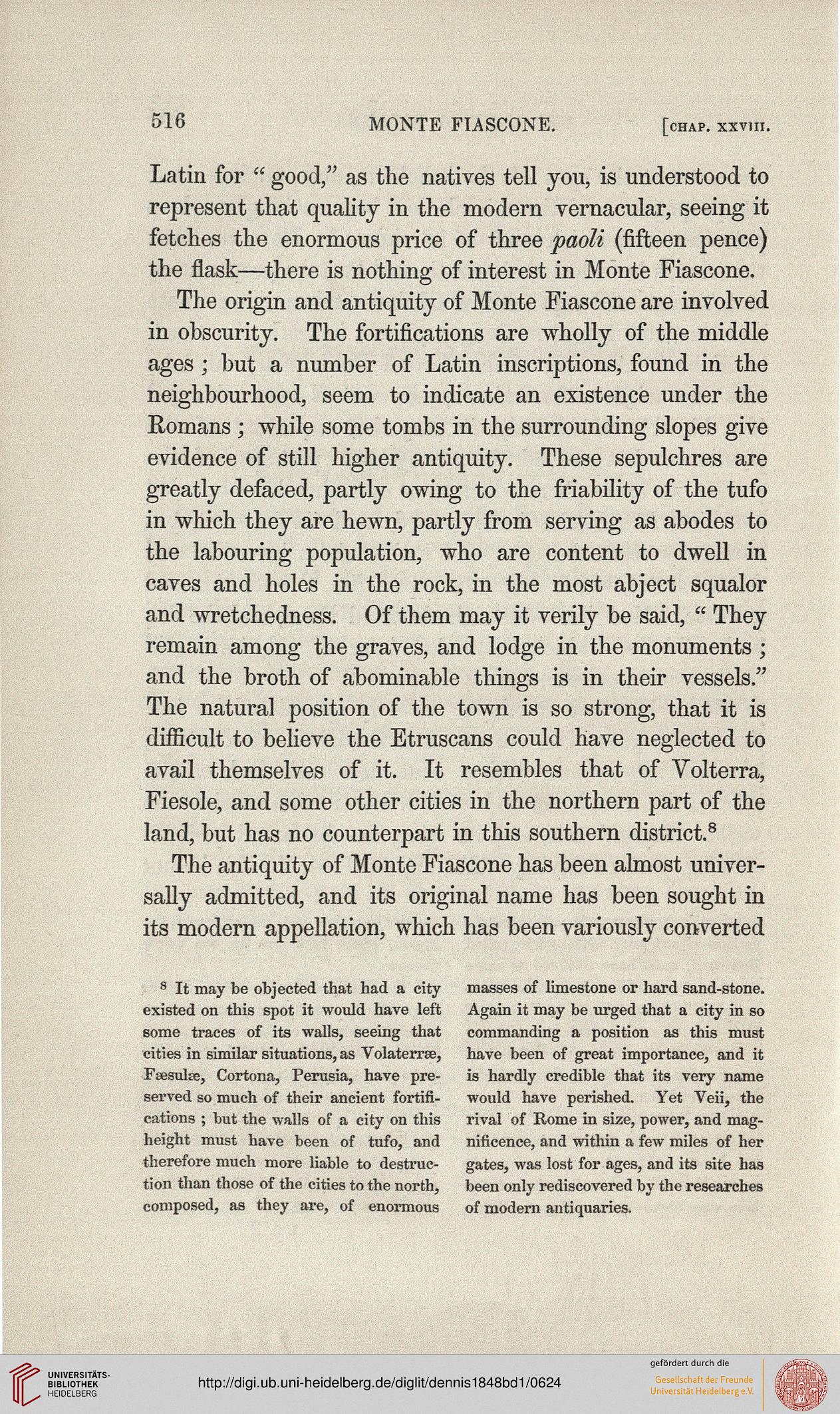516 MONTE FIASCONE. [chap, xxviii.
Latin for " good," as the natives tell you, is understood to
represent that quality in the modern vernacular, seeing it
fetches the enormous price of three paoli (fifteen pence)
the flask—there is nothing of interest in Monte Fiascone.
The origin and antiquity of Monte Fiascone are involved
in obscurity. The fortifications are wholly of the middle
ages ; but a number of Latin inscriptions, found in the
neighbourhood, seem to indicate an existence under the
Romans ; while some tombs in the surrounding slopes give
evidence of still higher antiquity. These sepulchres are
greatly defaced, partly owing to the friability of the tufo
in which they are hewn, partly from serving as abodes to
the labouring population, who are content to dwell in
caves and holes in the rock, in the most abject squalor
and wretchedness. Of them may it verily be said, " They
remain among the graves, and lodge in the monuments ;
and the broth of abominable things is in their vessels."
The natural position of the town is so strong, that it is
difficult to believe the Etruscans could have neglected to
avail themselves of it. It resembles that of Volterra,
Fiesole, and some other cities in the northern part of the
land, but has no counterpart in this southern district.8
The antiquity of Monte Fiascone has been almost univer-
sally admitted, and its original name has been sought in
its modern appellation, which has been variously converted
8 It may be objected that bad a city masses of limestone or bard sand-stone,
existed on this spot it would have left Again it may be urged that a city in so
some traces of its walls, seeing that commanding a position as this must
cities in similar situations, as Volaterrse, have been of great importance, and it
Fsesuhe, Cortona, Perusia, have pre- is hardly credible that its very name
served so much of their ancient fortifi- would have perished. Yet Veii, the
cations ; but the walls of a city on this rival of Rome in size, power, and mag-
height must have been of tufo, and nificence, and within a few miles of her
therefore much more liable to destruc- gates, was lost for ages, and its site has
tion than those of the cities to the north, been only rediscovered by the researches
composed, as they are, of enormous of modern antiquaries.
Latin for " good," as the natives tell you, is understood to
represent that quality in the modern vernacular, seeing it
fetches the enormous price of three paoli (fifteen pence)
the flask—there is nothing of interest in Monte Fiascone.
The origin and antiquity of Monte Fiascone are involved
in obscurity. The fortifications are wholly of the middle
ages ; but a number of Latin inscriptions, found in the
neighbourhood, seem to indicate an existence under the
Romans ; while some tombs in the surrounding slopes give
evidence of still higher antiquity. These sepulchres are
greatly defaced, partly owing to the friability of the tufo
in which they are hewn, partly from serving as abodes to
the labouring population, who are content to dwell in
caves and holes in the rock, in the most abject squalor
and wretchedness. Of them may it verily be said, " They
remain among the graves, and lodge in the monuments ;
and the broth of abominable things is in their vessels."
The natural position of the town is so strong, that it is
difficult to believe the Etruscans could have neglected to
avail themselves of it. It resembles that of Volterra,
Fiesole, and some other cities in the northern part of the
land, but has no counterpart in this southern district.8
The antiquity of Monte Fiascone has been almost univer-
sally admitted, and its original name has been sought in
its modern appellation, which has been variously converted
8 It may be objected that bad a city masses of limestone or bard sand-stone,
existed on this spot it would have left Again it may be urged that a city in so
some traces of its walls, seeing that commanding a position as this must
cities in similar situations, as Volaterrse, have been of great importance, and it
Fsesuhe, Cortona, Perusia, have pre- is hardly credible that its very name
served so much of their ancient fortifi- would have perished. Yet Veii, the
cations ; but the walls of a city on this rival of Rome in size, power, and mag-
height must have been of tufo, and nificence, and within a few miles of her
therefore much more liable to destruc- gates, was lost for ages, and its site has
tion than those of the cities to the north, been only rediscovered by the researches
composed, as they are, of enormous of modern antiquaries.




